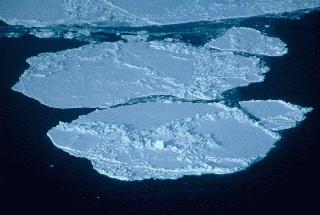Click on image for full size
NASA
Related links:
An Official South Pole Marker (NSF image)
South Pole Live Camera (US Antarctic Program)
Newly Unveiled Satellite Map of Antarctica Is a Unique Tool for Scientists, Educators and the Public
NSF Dedicates New South Pole Station
Study of Glacial Earthquakes Shakes Up Idea of How Ice Streams Move
The Antarctic Region
What Will You Find There?
If you travel to the South Pole, you will find the continent of Antarctica surrounded by the Southern Ocean. The geographic South Pole is marked by a large sign that scientists put into the ice. If you have a compass, you can find the magnetic South Pole. It is in a slightly different location than the geographic South Pole. Ice covers the land and tops the seas as ice shelves. In the night sky you may see the aurora. The aurora is called the Southern Lights here. There are large mountains and volcanoes and many types of birds such as penguins, albatrosses and skuas. Seals and whales live in the ocean water surrounding Antarctica, as well as tons of small shrimp-like creatures called krill that swim together in large schools.
Scientists in Antarctica
In the summer, many scientists travel to Antarctica to study the frozen continent. Most of the scientists live at research stations. The scientists visiting Antarctica are studying the living things, rocks, ocean, ice, climate, weather, and stars to better understand this part of our planet. A few people stay in Antarctica year-round, even during winter when there is little or no daylight.
The South Pole
On top of the ice that covers the land at the South Pole, scientists have marked the location of the geographic pole with a marker sign. The ice moves slowly every year, so the marker sign is no longer in the correct location after a while. Each year the marker moves approximately 10 meters (30 feet) away from the Pole as the ice flows. So, on the first day of January, scientists at the South Pole Station add another marker to show the real location of the geographic South Pole.














